We had a student who had a birthday today, Michael Goldstein, and if you’d been here to celebrate with him, here’s what you might have done:
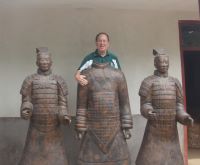
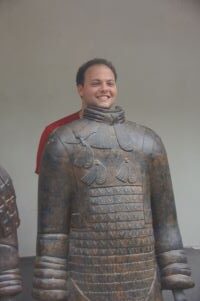
Most people come to Xi’an for the terra cotta warriors, and rightly so, but the first emperor who constructed them ruled China for only 15 years, and his dynasty lasted only 3 more years. The pride of China (the Midnight in Paris as it were) were the Tang, generally conceded (by Chinese) to have presided over the most prosperous and imaginative period in Chinese history. Certainly the Tang set standards for much of East Asia. It was the Tang period (600-900 roughly) that influenced Japan and Korea. In fact, if you go to Japan and look at the Buddhist temples, you’ll see the roofs that resemble Tang China more than its successors.
And, if you knew the importance of the Tang, you might have looked at the map, as I did, and found that one of the sites you’ve never visited (and you’ve been to Xi’an many times before) is the site of the Tang palace. After 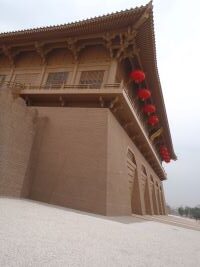 all, the current city wall surrounds what was the Ming version of Xi’an. We’re in the north side of the city, just outside the North Gate of that wall, and less than a mile from here is that Tang Palace park. You might have figured out that I’m an insomniac, and while China doesn’t cure that for me, it makes me glad I am, because it extends the day.
all, the current city wall surrounds what was the Ming version of Xi’an. We’re in the north side of the city, just outside the North Gate of that wall, and less than a mile from here is that Tang Palace park. You might have figured out that I’m an insomniac, and while China doesn’t cure that for me, it makes me glad I am, because it extends the day.
So at 6:30 am, I wandered off for an hour and a half through the city, focusing on visiting those ruins. I saw the excavations and attempts to build up the three south gates to what was a huge palace, and if I get a chance to go back tomorrow, there’s a small museum with some of the artifacts from the palace.
You would have been more likely to join the rest of our team for the 9 am tour to the terracotta warriors—after all, no foreigners (other than me) were at the Tang DeMing Gong Yuan (the palace park), and none were spotted on my walk back through tree-lined (sycamores) side streets of Xi’an.
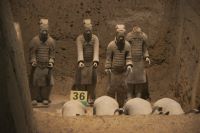
 The emperor’s tomb complex is about 20 miles from the current city of Xi’an, located where there was favorable feng shui. The emperor himself has enjoyed periods of fame and infamy (our guide stressed that even though the Zhou and Shang states predated the First Emperor, they don’t count because they were based on slavery!) partly because on the one hand he unified the country, reconstituted the great wall, standardized the currency and roads, and gave his name to the country (he was from the state of Qin); on the other hand he had a rapacious appetite for monuments to himself, which led in turn to forced labor (20,000 workers built the tomb complex, and he reputedly killed them all to preserve secrecy—can you believe that the tombs lay undiscovered after the immediate aftermath of his dynastic fall until 1974, when a head appeared in the retrieval of matter from a well being drilled on the site). He also burned books that he did not like, and killed scholars who refused to tell him ways to live forever, and subsequent scholars have gotten their revenge.
The emperor’s tomb complex is about 20 miles from the current city of Xi’an, located where there was favorable feng shui. The emperor himself has enjoyed periods of fame and infamy (our guide stressed that even though the Zhou and Shang states predated the First Emperor, they don’t count because they were based on slavery!) partly because on the one hand he unified the country, reconstituted the great wall, standardized the currency and roads, and gave his name to the country (he was from the state of Qin); on the other hand he had a rapacious appetite for monuments to himself, which led in turn to forced labor (20,000 workers built the tomb complex, and he reputedly killed them all to preserve secrecy—can you believe that the tombs lay undiscovered after the immediate aftermath of his dynastic fall until 1974, when a head appeared in the retrieval of matter from a well being drilled on the site). He also burned books that he did not like, and killed scholars who refused to tell him ways to live forever, and subsequent scholars have gotten their revenge.
If you’d joined Michael and his classmates today, you would have seen the four basic complexes that are now open—Pit Number 1, the best known, was 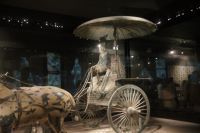 opened in 1979, and houses the infantry. Two more accommodate other armies designed to guard the emperor in the hereafter. The main pit originally collapsed after the rebelling populace burned the tomb, smashing most of the 8,000 warriors. There are now around 2000 reconstructed—and you might have thought jigsaw puzzles were difficult! The other display is of some bronze chariots that are exquisite.
opened in 1979, and houses the infantry. Two more accommodate other armies designed to guard the emperor in the hereafter. The main pit originally collapsed after the rebelling populace burned the tomb, smashing most of the 8,000 warriors. There are now around 2000 reconstructed—and you might have thought jigsaw puzzles were difficult! The other display is of some bronze chariots that are exquisite.
The big question mark is the emperor’s tomb itself, supposedly a recreation of the universe (with mercury serving as the sea) that remains unopened. The consensus is that the Chinese await the technology to prevent oxygen from destroying silk, wood, and colors, as has happened with many other tombs, and even to parts of the terracotta army.
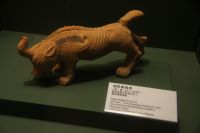
 We spent a little time in the splendid provincial museum that demonstrates the importance of the province and the city in Chinese history, with artefacts especially from the Qin, Han, and Tang periods.
We spent a little time in the splendid provincial museum that demonstrates the importance of the province and the city in Chinese history, with artefacts especially from the Qin, Han, and Tang periods.
The interesting thing about the Tang period is the importance of two women. One, the Empress Wu, took over for her husband and ruled China. She was the only female to claim the title, though Tzu-hsi, a concubine who rose to queen mother and poisoned a number of emperors was the power behind the throne until her death in 1908 (you might remember her from The Last Emperor), and Madame Chiang and Madame Mao might have acted the role! She had, our guide kept emphasizing, a desire to be more powerful than the males, which she demonstrated by having male concubines (shucks, I told our guide, so did many empresses, including Catherine the Great, whose biography I read this year), and by constructing a lion standing up to guard a building, which is quite rare in China. The other was a famous concubine, who was “plump,” and set the bar for beauty in Tang China.
If you were to celebrate your birthday with us, you might have asked the guide for an unusual dinner in Xi’an. We had the famous Xi’an dumplings last night (some in the shape of a chicken, which were filled with chicken; 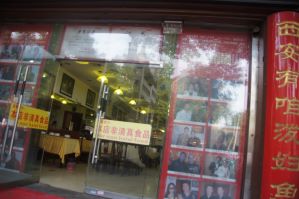 my favorite was the walnut shaped dumpling, filled with walnuts). She suggested Muslim food. One of the consequences of Chang’an’s position as a world leader in trade (the Silk Road ended here) is that foreign traders came. Unlike India, where the Muslim contact was, at times, military and political, Muslims settled in Xi’an, and have been here for centuries.
my favorite was the walnut shaped dumpling, filled with walnuts). She suggested Muslim food. One of the consequences of Chang’an’s position as a world leader in trade (the Silk Road ended here) is that foreign traders came. Unlike India, where the Muslim contact was, at times, military and political, Muslims settled in Xi’an, and have been here for centuries.
She suggested a special meal for Michael’s birthday that consisted of a lamb stew that was made famous by an emperor (who started a dynasty), who had started life as a beggar. He begged for bread, which got hard, and then he put it into a soup, and lo and behold, when he became emperor, everyone agreed with him (which is why I want to be emperor) that it was one of the most tasty dishes they had ever eaten. It was certainly a different way to spend your birthday.
 After the dinner, we went to one of the best shows in China, the Tang dynasty show. Ruth Ann and I had seen it several times before, and knew it was spectacular. What Michael did not know was that we’d arranged to have a birthday cake brought to him by two of the Tang performers, who gave him a dao (a halyard?) to cut it. The choreography was even better than I remembered, and some of the musical instruments the cast used were
After the dinner, we went to one of the best shows in China, the Tang dynasty show. Ruth Ann and I had seen it several times before, and knew it was spectacular. What Michael did not know was that we’d arranged to have a birthday cake brought to him by two of the Tang performers, who gave him a dao (a halyard?) to cut it. The choreography was even better than I remembered, and some of the musical instruments the cast used were 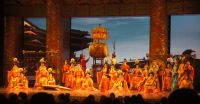
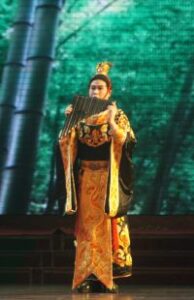 archaic. One that is haunting sounds like an oriole—the emperor commanded a musician to write a piece for him that sounded like an oriole, which had sung for the emperor’s coronation (I can’t remember when I’ve seen anything other than an English sparrow in China, but the Tang dynasty was a long time ago).
archaic. One that is haunting sounds like an oriole—the emperor commanded a musician to write a piece for him that sounded like an oriole, which had sung for the emperor’s coronation (I can’t remember when I’ve seen anything other than an English sparrow in China, but the Tang dynasty was a long time ago).
So, if you have a birthday coming up, you may want to spend it in Xi’an, because I don’t think you can do the things I’ve described in Chicago.
Happy Birthday, Michael.